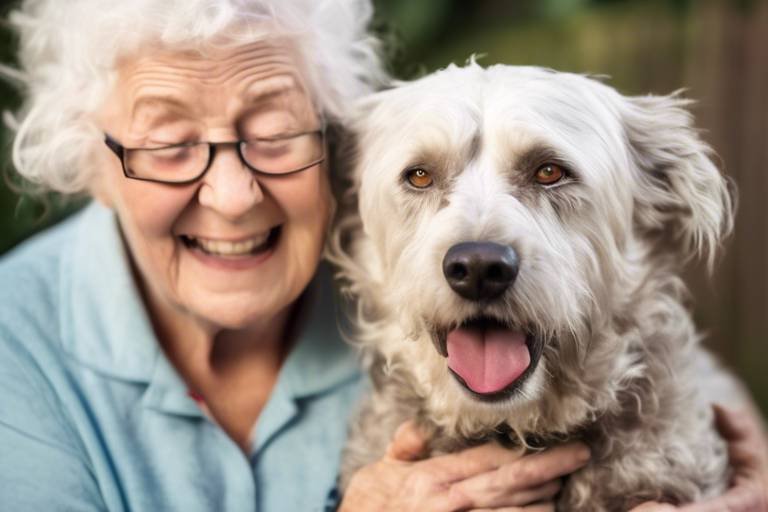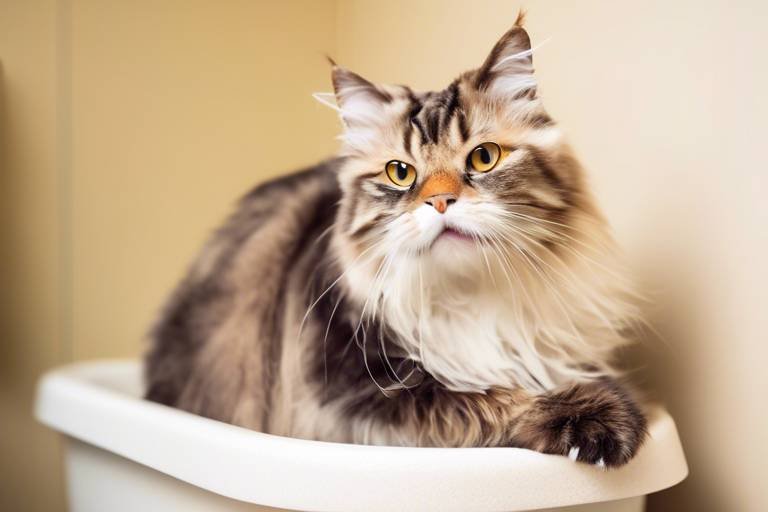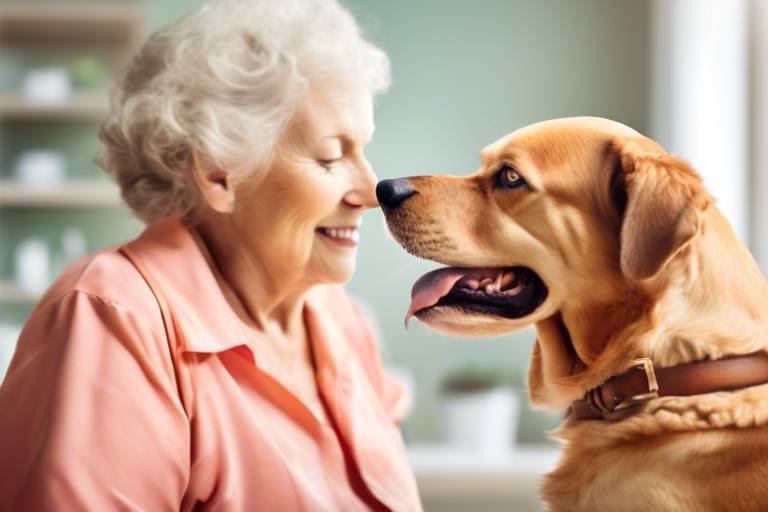The Role of Enrichment in Senior Pet Care
As our beloved furry companions age, their needs evolve, and it's our responsibility to ensure they continue to thrive in their golden years. Enrichment activities play a crucial role in enhancing the quality of life for senior pets, addressing their physical, mental, and emotional well-being. Just like humans, pets experience changes as they grow older, and providing them with appropriate stimulation can make a world of difference. Imagine a world where your aging pet feels vibrant, engaged, and loved—this is the magic of enrichment!
Enrichment isn't just about keeping them entertained; it's about fostering an environment where they can flourish. Think of it as creating a mini-adventure for your pet every day. Whether it's a new toy that challenges their mind or a leisurely stroll in the park, each activity contributes to their overall happiness. In this article, we will delve into the various aspects of enrichment tailored specifically for senior pets, ensuring they lead a fulfilling life as they age gracefully.
As pets age, their physical and emotional needs change significantly. Older pets may experience decreased energy levels, arthritis, or even cognitive decline. Understanding these unique requirements is key to providing better care and enrichment strategies. For instance, while a young dog might thrive on high-energy games, a senior dog may prefer gentle activities that allow them to engage without overexerting themselves.
Moreover, emotional well-being is just as important as physical health. Senior pets often face loneliness and anxiety, especially if they have lost companions or if their human family members are away for long periods. Recognizing these changes allows pet owners to tailor enrichment activities that not only engage their pets physically but also provide mental and emotional support.
Enrichment activities can be broadly categorized into three types: physical, mental, and social stimulation. Each type addresses specific needs of senior pets, helping them maintain a balanced and joyful life. Let's explore these categories in detail.
Physical enrichment involves activities that promote movement and exercise. Gentle exercise routines tailored to senior pets are essential for maintaining their health and mobility. Regular, low-impact activities can help manage weight, improve circulation, and enhance flexibility.
Interactive toys can provide mental stimulation while encouraging physical activity. These toys are designed to engage your pet's mind and keep them entertained for hours. Look for toys that require problem-solving skills, such as treat-dispensing puzzles. Not only do they challenge your pet mentally, but they also promote movement as they interact with the toy.
Leisurely walks are essential for maintaining a senior pet's physical health. While they may not be able to handle long hikes like they used to, short, slow-paced walks can be incredibly beneficial. Consider the following tips to implement safe and enjoyable walking routines:
- Choose flat, even surfaces to prevent strain on their joints.
- Keep walks short, around 10-15 minutes, and gradually increase as tolerated.
- Always bring water and take breaks as needed.
Mental stimulation is crucial for keeping senior pets sharp and engaged. Activities like hide-and-seek with treats or simple training exercises can challenge their minds and prevent cognitive decline. Engaging their senses through scent games or interactive play can keep their brains active and alert.
Social interaction is vital for a senior pet's emotional health. Regularly socializing with other pets and humans can foster companionship and reduce feelings of loneliness. A well-rounded social life can significantly enhance your pet's mood and overall well-being.
Organizing playdates can be beneficial for senior pets. When arranging these gatherings, consider the energy levels and physical capabilities of all involved pets. Gentle play can provide a refreshing change of pace for older animals, allowing them to enjoy the company of their peers without the stress of overly energetic play.
Therapy and comfort animals can provide emotional support for senior pets. The presence of a calm and friendly animal can help alleviate anxiety and promote relaxation. This companionship can be particularly beneficial for pets who have experienced loss or changes in their environment.
Q: How often should I engage my senior pet in enrichment activities?
A: Aim for daily activities that are short and varied to keep your pet engaged without overwhelming them.
Q: What types of toys are best for senior pets?
A: Look for soft, easy-to-handle toys that are safe and promote gentle play. Interactive toys that stimulate their mind are also great options.
Q: Can I introduce new pets to my senior pet?
A: Yes, but introduce them slowly and observe your senior pet's reactions. Ensure that the new pet is calm and respectful of your senior's space.
Q: How do I know if my senior pet is enjoying enrichment activities?
A: Look for signs of engagement, such as wagging tails, playful behavior, or a relaxed demeanor. If they seem disinterested or stressed, it may be time to adjust the activity.

Understanding Senior Pet Needs
As our furry friends age, their needs evolve in ways that can sometimes catch us off guard. Just like humans, senior pets experience changes in their physical health, emotional state, and even their social interactions. Understanding these unique requirements is crucial for ensuring their well-being and happiness. Think of it as tuning into a different frequency; the same love and care you’ve always provided may need to be adjusted to meet their new needs.
One of the most significant shifts in senior pets is their physical capabilities. Aging pets may develop conditions such as arthritis, reduced mobility, or sensory impairments. These changes can affect their ability to engage in activities they once loved. For instance, a once-energetic dog that enjoyed long runs might now prefer leisurely strolls or gentle play sessions. Recognizing these limitations allows you to tailor enrichment activities that are both safe and enjoyable.
Moreover, senior pets often face cognitive decline. Just like us, they can experience memory loss and confusion as they age. This decline can lead to anxiety and stress, making mental stimulation even more vital. Engaging your pet with puzzles, interactive toys, or even simple training exercises can help keep their minds sharp and their spirits high. You wouldn't want to let your beloved companion drift into a world of boredom and disinterest, would you?
Another critical aspect to consider is their emotional health. Senior pets can become more anxious or depressed, especially if they’ve lost a companion or if their environment has changed. They thrive on routine and familiarity. Introducing new activities or routines gradually can ease them into changes without overwhelming them. Social interaction, whether with humans or other pets, can significantly boost their mood and overall well-being. After all, who doesn’t enjoy a little company?
To summarize, understanding the needs of senior pets involves a holistic approach that considers their physical, mental, and emotional well-being. Here’s a quick recap of what to keep in mind:
- Physical health: Be aware of mobility issues and adjust activities accordingly.
- Cognitive function: Provide mental stimulation to prevent cognitive decline.
- Emotional support: Foster social interactions and maintain a stable environment.
By paying attention to these aspects, you can create a nurturing environment that enhances the quality of life for your aging furry companions. After all, they’ve been by your side through thick and thin; it’s time to return the favor!

Types of Enrichment Activities
This article explores the importance of enrichment activities for senior pets, focusing on their physical, mental, and emotional well-being. Discover how to enhance the quality of life for your aging furry companions.
As pets age, their physical and emotional needs change. This section discusses the unique requirements of senior pets and how understanding these needs can lead to better care and enrichment strategies.
When it comes to enriching the lives of our senior pets, it's essential to recognize that they thrive on a variety of activities that cater to their unique needs. Enrichment activities can be broadly categorized into three main types: physical, mental, and social stimulation. Each category plays a vital role in improving the overall well-being of aging pets. Let's dive deeper into these categories to understand how we can make our furry friends' lives more fulfilling.
Physical enrichment is all about keeping our senior pets active and engaged. Gentle exercise routines tailored specifically for senior pets can significantly contribute to maintaining their health and mobility. Regular movement helps prevent obesity, reduces the risk of arthritis, and keeps their hearts healthy. Activities such as interactive toys and leisurely walks are great ways to incorporate physical enrichment into their daily routine.
Interactive toys can provide both mental stimulation and encourage physical activity. These toys often require pets to engage in problem-solving behaviors, which can keep their minds sharp. Popular options include puzzle feeders and toys that dispense treats when manipulated correctly. Not only do these toys challenge their intellect, but they also motivate them to move around, keeping their bodies active.
Leisurely walks are essential for maintaining a senior pet's physical health. Unlike younger pets that might be able to handle long, vigorous walks, senior pets often require shorter, more relaxed strolls. It's important to pay attention to their pace and energy levels. Aim for a routine that includes multiple short walks throughout the day, allowing them to explore their environment at their own speed. This not only helps with physical health but also provides sensory stimulation, which can be incredibly enriching.
Mental stimulation is crucial for keeping senior pets sharp and engaged. Activities like hide-and-seek, where you hide treats around the house for your pet to find, can be both fun and stimulating. Additionally, training sessions that involve simple commands or tricks can keep their minds active. Remember, mental challenges can be just as tiring as physical exercise for our furry companions, so mix it up to keep things interesting!
Social interaction is vital for a senior pet's emotional health. Engaging with other pets and humans can foster companionship and reduce feelings of loneliness. Whether it’s a playdate with a friendly neighbor's dog or simply spending time with family members, socializing can significantly enhance your pet's quality of life.
Organizing playdates can be beneficial for senior pets. It's essential to consider their energy levels and needs when arranging these gatherings. Opt for calm, gentle playmates who won't overwhelm your senior pet. Supervised playdates can help maintain their social skills and provide an avenue for exercise in a safe environment.
Therapy and comfort animals can provide emotional support for senior pets. The presence of a calm, friendly animal can help alleviate anxiety and stress, creating a comforting atmosphere for your aging pet. Many therapy programs offer visits from trained animals, which can be a wonderful way to introduce companionship into your senior pet's life.
- What is the best way to start enrichment activities for my senior pet? Begin by observing your pet's preferences and limitations. Gradually introduce new activities that align with their interests and physical capabilities.
- How often should I engage my senior pet in enrichment activities? Aim for daily activities, but keep them short and varied to avoid overwhelming your pet. Quality over quantity is key!
- Can enrichment activities help with my pet's anxiety? Absolutely! Engaging your pet in social and mental activities can reduce anxiety and promote a sense of security.
Physical Enrichment
When it comes to our beloved senior pets, plays a pivotal role in ensuring their overall health and happiness. As pets age, they may not be as spry as they once were, but that doesn't mean they don't need to stay active. In fact, gentle exercise routines are essential for maintaining their mobility and preventing obesity, which can lead to a myriad of health issues. Think of it this way: just like us, our furry friends need to keep moving to stay in tip-top shape!
One of the best ways to incorporate physical enrichment into your senior pet's routine is through interactive play. This can include engaging them with toys that require movement, such as balls or soft frisbees designed for easy catching. Not only does this encourage your pet to get up and move, but it also provides a fun bonding experience between you and your furry friend. Remember, the key here is to choose toys that are appropriate for their age and physical condition. For instance, a gentle tug-of-war with a soft toy can be a delightful way to stimulate both their body and mind.
Another fantastic form of physical enrichment is going for leisurely walks. These walks are not just about getting from point A to point B; they are opportunities for exploration and social interaction. A leisurely stroll allows your senior pet to sniff around, which is a natural behavior that provides mental stimulation. When planning these walks, keep in mind the following considerations:
| Factors to Consider | Recommendations |
|---|---|
| Distance | Start with short distances and gradually increase based on your pet's comfort level. |
| Terrain | Choose flat, even surfaces to avoid strain on their joints. |
| Weather | Avoid extreme temperatures; early mornings or late evenings are ideal. |
Additionally, consider using a harness instead of a collar for better control and comfort. This is especially important for senior pets who may have neck issues. The goal is to make these walks enjoyable and stress-free, allowing your pet to savor the experience.
Incorporating water activities can also be an excellent way to provide physical enrichment for senior pets. Swimming is a low-impact exercise that is gentle on their joints while still offering a great workout. If your pet enjoys water, consider taking them to a dog-friendly beach or a local pool designed for pets. Always supervise them closely to ensure their safety, and remember to keep sessions short to avoid fatigue.
Ultimately, the key to successful physical enrichment is to tailor activities to your senior pet's specific needs and abilities. By keeping their exercise routine varied and engaging, you can help your furry companion maintain a healthy weight, improve their mobility, and most importantly, enhance their overall quality of life. So, let’s get moving and make those tails wag!
Interactive Toys
When it comes to keeping our senior pets engaged and active, can be a game changer! These toys are not just about fun; they serve a vital role in enhancing the quality of life for our aging companions. As pets grow older, their play needs evolve. Unlike the energetic puppies and kittens that bounce around with unending enthusiasm, senior pets often require more gentle stimulation. This is where interactive toys come into play.
Interactive toys are designed to challenge your pet mentally while also encouraging them to move around. Think of them as a workout for their brains and bodies! For instance, puzzle toys that dispense treats can motivate your furry friend to think critically about how to get their reward, combining mental and physical activity. These toys stimulate their natural instincts and keep their minds sharp, which is crucial for preventing cognitive decline.
Here are some types of interactive toys that are particularly beneficial for senior pets:
- Puzzle Feeders: These toys require pets to solve a puzzle to access their food or treats. They are fantastic for keeping your pet engaged and can help slow down their eating.
- Snuffle Mats: These mats encourage pets to use their noses to find hidden treats, providing both mental stimulation and a fun scavenger hunt experience.
- Soft Chew Toys: For senior pets with dental issues, soft chew toys can provide comfort while still encouraging play.
Choosing the right interactive toy is essential. Make sure to consider your pet's physical abilities and preferences. For example, if your senior dog has arthritis, opt for toys that require minimal jumping or strenuous movement. Always supervise playtime to ensure safety, as older pets can be more prone to injuries.
In addition to keeping your pet entertained, interactive toys can also strengthen the bond between you and your furry friend. Engaging in playtime together can be a delightful way to spend quality time, providing both of you with joy and companionship. So, go ahead and explore the world of interactive toys; your senior pet will thank you for it!
Leisurely Walks
Leisurely walks are not just a routine; they are a vital part of a senior pet's physical and mental well-being. As our furry companions age, their energy levels may dwindle, but that doesn't mean they should miss out on the joys of the outside world. In fact, gentle strolls can be one of the most rewarding activities for both pets and their owners. Picture this: a sunny day, a gentle breeze, and your beloved pet happily sniffing around, exploring the wonders of nature at a pace that suits their comfort. It’s not just about exercise; it’s about bonding, exploration, and enjoyment.
When planning leisurely walks for senior pets, it’s essential to consider their unique needs. Many older pets may suffer from arthritis or other mobility issues, which means that a rigorous hike is out of the question. Instead, aim for short, frequent walks that allow them to stretch their legs without overexerting themselves. Here are a few tips to keep in mind:
- Choose the Right Time: Early mornings or late afternoons are often the best times to walk, avoiding the heat of the day.
- Pick a Suitable Route: Opt for flat, even surfaces to minimize strain on their joints.
- Monitor Their Pace: Let your pet dictate the speed of the walk. If they want to stop and sniff, let them!
Additionally, it's crucial to keep an eye on the weather. Hot pavement can burn sensitive paws, and cold weather can be harsh on older joints. Invest in a good quality leash and harness that provides comfort and control, ensuring your pet feels secure throughout the walk. If your senior pet is particularly unsteady, consider using a supportive harness that can help lift them if needed.
Remember, the goal of these walks is not just exercise, but also to foster a sense of adventure and exploration. Take the time to let your pet engage with their surroundings. Allow them to stop and smell the flowers, greet other dogs, or simply bask in the sunlight. These moments of engagement are crucial for their emotional health and can significantly enhance their quality of life.
In conclusion, leisurely walks are a wonderful way to keep senior pets active and happy. They provide a perfect opportunity for exercise while also serving as a platform for social interaction and mental stimulation. By adapting the walks to suit your pet's needs, you can create a fulfilling experience that both you and your furry friend will cherish.
Q: How long should I walk my senior pet?
A: Aim for short walks of about 10 to 20 minutes, depending on your pet's stamina and comfort level. It's better to have multiple short walks than one long one.
Q: What should I do if my senior pet shows signs of fatigue during the walk?
A: If your pet seems tired, take a break in a shaded area or head home. Always prioritize their comfort and well-being.
Q: Are there any specific breeds that require more or less walking as seniors?
A: Yes, some breeds may require more exercise than others, even in their senior years. Consult your veterinarian for tailored advice based on your pet's breed and health condition.
Mental Stimulation
Mental stimulation is crucial for keeping our senior pets sharp and engaged. Just like humans, as pets age, their cognitive functions can decline, leading to issues such as confusion, anxiety, and even depression. Imagine your beloved furry friend sitting in a corner, looking lost and disinterested. It’s heartbreaking, isn’t it? But the good news is that we can do something about it! By incorporating various activities and games designed to challenge their minds, we can prevent cognitive decline and promote a happier, healthier life for our aging companions.
One of the simplest yet most effective ways to provide mental stimulation is through interactive games. Think of puzzle toys that require your pet to think critically to get a treat. These toys not only keep their minds active but also reward them for their efforts, creating a sense of accomplishment. You might find that your dog or cat becomes more animated and engaged, almost like they’ve rediscovered their youthful spirit!
Another fantastic way to stimulate your senior pet's mind is through scent games. Dogs, in particular, have an incredible sense of smell, and using this to your advantage can be both fun and beneficial. Hide treats around the house and encourage your pet to find them. This not only engages their sense of smell but also gives them a little exercise as they move around, searching for their hidden treasures. For cats, consider using feather wands or laser pointers to encourage them to chase and pounce, which can mimic their natural hunting instincts.
Moreover, regular training sessions can also serve as excellent mental exercises. Teaching your senior pet new tricks or reinforcing basic commands can keep their minds sharp. It’s a win-win situation: your pet gets mental stimulation, and you get to bond with them over shared learning experiences. Remember, patience is key, as older pets may take a bit longer to pick things up, but the joy on their faces when they finally get it is worth the wait!
Lastly, don’t underestimate the power of routine changes. Sometimes, simply changing the route of your daily walk or introducing new toys can provide a fresh perspective for your pet. Just like us, they can get bored with the same old routine. By mixing things up, you can keep their minds active and engaged, making every day feel like an adventure!
- What are some signs that my senior pet needs more mental stimulation?
Signs can include increased lethargy, disinterest in play, and changes in behavior such as increased anxiety or restlessness. If your pet seems bored or disengaged, it might be time to introduce new activities.
- How often should I engage my senior pet in mental stimulation activities?
Try to incorporate mental stimulation activities into your pet’s daily routine. Even short sessions of 10-15 minutes can be beneficial, and you can gradually increase the duration as your pet becomes more engaged.
- Are there specific toys recommended for senior pets?
Yes! Look for toys that are designed for older pets, which often include softer materials and are easier to manipulate. Puzzle toys, treat-dispensing toys, and interactive games are great options.

Social Interaction
When it comes to our beloved senior pets, is not just a luxury; it's a necessity. Just like humans, pets thrive on companionship and connection. As they age, many senior pets may experience feelings of loneliness or isolation, which can lead to anxiety and depression. Imagine being stuck in a room all day without anyone to talk to or play with—it's no different for our furry friends! Providing them with opportunities for socialization can significantly enhance their emotional well-being.
One of the best ways to boost your senior pet's social life is by introducing them to other animals and people. This could be as simple as inviting friends over who have pets or taking your furry companion to a local dog park during off-peak hours. However, it's essential to consider the temperament and energy levels of your pet and their potential playmates. Not all dogs or cats will mesh well together, especially if one is much older or slower. Always supervise interactions to ensure a safe and enjoyable experience for everyone involved.
Additionally, playdates can be a fantastic way to foster social skills and provide mental stimulation. Organizing these gatherings can be as easy as coordinating with a neighbor or a friend who has a gentle pet. Remember, the goal is to create a relaxed atmosphere where your senior pet can engage at their own pace. Here are a few tips to make playdates successful:
- Choose a quiet location where both pets feel comfortable.
- Keep the play sessions short to avoid overwhelming your senior pet.
- Provide plenty of breaks and fresh water.
Another wonderful option is to consider introducing therapy and comfort animals into your senior pet's life. These specially trained animals can offer emotional support and companionship, helping to alleviate feelings of loneliness. Therapy animals can visit homes or facilities, providing gentle interaction that can brighten the day of any senior pet. The presence of a calm, friendly animal can work wonders, creating a sense of security and joy.
In conclusion, social interaction is vital for the emotional health of senior pets. By facilitating playdates and considering therapy animals, you can help your furry companions lead happier, more fulfilling lives. After all, a happy pet is a healthy pet, and the love and joy they bring to our lives are immeasurable!
Playdates
Organizing for senior pets is not just a delightful way to break the monotony of their daily routine; it’s a crucial element in enhancing their overall quality of life. Imagine your furry friend, tail wagging, as they reconnect with their buddies or make new friends at the park. Just like humans, pets thrive on social interaction, and for senior animals, these moments can be incredibly revitalizing. But how do you ensure that these playdates are both safe and enjoyable? Let’s delve into some practical tips and considerations.
First and foremost, it’s essential to choose the right companions for your senior pet. Not all pets are created equal, and their energy levels, temperaments, and health conditions can vary significantly. Look for playmates that are:
- Similar in Age: Pairing your senior pet with younger, more energetic dogs might lead to exhaustion or even injuries. Opt for pets of a similar age or energy level.
- Gentle and Friendly: Ensure that the other pets are well-socialized and have a gentle demeanor. This helps prevent any overwhelming situations that could stress your aging companion.
- Health Considerations: Always check if the other pets are up-to-date on vaccinations and free from contagious illnesses to protect your senior pet’s health.
Once you’ve selected the perfect playdate partner, it’s time to plan the actual meeting. Here are some key points to keep in mind:
- Choose a Safe Environment: Whether it’s a fenced backyard or a local dog park, ensure that the area is safe and free from hazards. Look for spaces that are not overly crowded to avoid overwhelming your pet.
- Monitor Playtime: Keep a close eye on the interaction. While it’s great to let them explore and play, be ready to step in if things get too rambunctious or if one pet seems stressed.
- Short Sessions: Start with shorter playdates and gradually increase the duration as your pet becomes more comfortable. Remember, senior pets can tire quickly, and it’s important to respect their limits.
After the playdate, don’t forget to reward your senior pet with some relaxation time and perhaps a few treats. Just like a good nap after a fun day out, this will help them recharge and process their experiences. Moreover, monitor their behavior post-playdate; if they seem unusually tired or stressed, it might be a sign to adjust the frequency or duration of future playdates.
In conclusion, playdates can be a fantastic way to enrich the lives of senior pets, offering them not just physical activity but also emotional fulfillment. Just like us, our furry friends need companionship and engagement to stay happy and healthy. By carefully planning and considering their needs, you can create enjoyable experiences that will keep their spirits high and their tails wagging.
Q1: How often should I arrange playdates for my senior pet?
A1: It depends on your pet's energy level and health. Start with once a week and adjust based on their response.
Q2: What if my senior pet doesn't enjoy playdates?
A2: Not all pets are social butterflies. If your pet seems anxious or uninterested, it might be best to explore other enrichment activities.
Q3: Can I have playdates with different types of animals?
A3: While some pets may get along well with different species, it's generally safer to arrange playdates with similar types of animals.
Q4: How can I tell if my pet is enjoying the playdate?
A4: Look for signs of happiness, such as wagging tails, playful behavior, and a relaxed demeanor. If they seem stressed or withdrawn, it might be time to end the playdate.
Therapy and Comfort Animals
When it comes to enhancing the emotional well-being of senior pets, can play a transformative role. These specially trained animals are not just furry companions; they bring a wave of comfort and joy that can significantly uplift the spirits of aging pets. Imagine your senior dog, who may not have the same energy levels as before, suddenly brightening up at the sight of a gentle, friendly therapy dog. It’s like a spark of vitality igniting a flickering flame!
Therapy animals are often used in various settings, from hospitals to nursing homes, and their impact is profound. For senior pets, the presence of a therapy animal can reduce feelings of loneliness and anxiety. Just like humans, pets can experience emotional distress, especially as they age and face changes in their environment or health. The companionship of a therapy animal can help ease these feelings, providing a sense of security and comfort.
Moreover, therapy animals can encourage social interaction between pets and their owners. For instance, when a therapy dog visits a senior pet, it can create a social atmosphere that makes the owner feel more connected as well. This interaction can be incredibly beneficial for both the human and animal participants, fostering a community of support and love.
In addition to therapy animals, comfort animals also serve a significant purpose. These animals are typically pets that have been trained to provide emotional support. They can be particularly effective for senior pets who may feel isolated or anxious. The presence of a comfort animal can create a calming environment, allowing senior pets to feel safe and cherished.
Here’s a quick overview of how therapy and comfort animals can benefit senior pets:
| Benefits | Description |
|---|---|
| Emotional Support | Helps reduce anxiety and feelings of loneliness. |
| Social Interaction | Encourages interaction between pets and their owners. |
| Physical Activity | Can motivate senior pets to engage in gentle play. |
| Routine Establishment | Provides structure through regular visits and interactions. |
It’s essential to choose the right therapy or comfort animal for your senior pet. Consider factors such as size, temperament, and energy level. A calm and gentle animal will likely be more beneficial than a hyperactive one. Additionally, always supervise interactions between your senior pet and therapy animals to ensure safety and comfort for both parties.
In conclusion, therapy and comfort animals can significantly enhance the quality of life for senior pets. They provide not just companionship but a sense of purpose and joy that can make the golden years truly shine. So, if you’re looking for ways to enrich the life of your aging furry friend, consider introducing them to the wonderful world of therapy and comfort animals!
Frequently Asked Questions
- What is pet enrichment and why is it important for senior pets?
Pet enrichment refers to activities and experiences that stimulate a pet's mind, body, and emotions. For senior pets, enrichment is crucial as it helps maintain their physical health, prevents cognitive decline, and enhances their overall quality of life. Just like us, pets thrive when they have engaging activities to participate in!
- How can I tell if my senior pet needs more enrichment?
If your senior pet seems lethargic, disinterested in play, or shows signs of anxiety or restlessness, it might be time to introduce more enrichment activities. Look for changes in behavior; if they seem bored or less active, it’s a sign they could benefit from more stimulation!
- What types of physical enrichment are suitable for senior pets?
Gentle activities like short, leisurely walks, low-impact games, and interactive toys designed for older pets are great options. It’s essential to adapt the intensity of these activities to match your pet's physical abilities, ensuring they stay safe while having fun!
- Are there specific toys recommended for senior pets?
Absolutely! Look for soft, easy-to-grip toys that encourage gentle play. Puzzle toys that dispense treats can also provide mental stimulation without requiring excessive physical exertion. Remember, the goal is to keep things fun and engaging without overwhelming them!
- How can I safely socialize my senior pet with other animals?
Start by introducing your senior pet to calm, friendly animals in a controlled environment. Monitor their interactions closely and keep play sessions short to avoid exhaustion. Gradually increase the duration as they become more comfortable. Socialization can be a fantastic way to enhance their emotional well-being!
- What are the benefits of therapy animals for senior pets?
Therapy animals can provide companionship and emotional support, helping to reduce feelings of loneliness and anxiety in senior pets. Their calming presence can encourage older pets to engage more with their surroundings, promoting a happier and healthier lifestyle!
- How often should I engage my senior pet in enrichment activities?
It’s ideal to incorporate some form of enrichment into your senior pet's daily routine. A mix of physical, mental, and social activities throughout the week can keep them stimulated and content. Just remember to tailor the activities to their energy levels and health status!



















